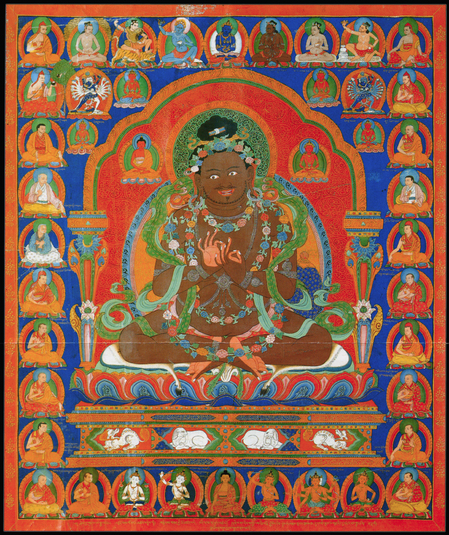
Item: Indian Adept (siddha) - Virupa
| Origin Location | Tibet |
|---|---|
| Date Range | 1500 - 1599 |
| Lineages | Sakya and Ngor (Sakya) |
| Material | Ground Mineral Pigment on Cotton |
| Collection | Private |
Virupa, Yogeshvara (837-909 approx.) and the Spontaneously Arising Accomplishment Lineage.
Wisdom Calendar 1996 - Cover (full catalog list)
At the bottom right is Drangti Namkha Palzang (1532-1602 [TBRC P777]) of the Thartse Labrang and the 13th Ngor Monastery supreme abbot.
Lower Register Figures from the Bari Gyatsa: The six meditational deities in the bottom register are drawn from the text known as the Bari Gyatsa. Starting at the left is Arapachana Manjushri, white in colour, followed by white Sthira Chakra Manjushri, Vajrasana Shakyamuni Buddha, orange Sthira Chakra Manjushri, orange Manjuvajra with three faces and six arms and orange Manjuvajra with one face and two arms.
[1] Muni Vajrasana [Shakyamuni Buddha]. [Above] blue Visnu, white Brahma, green Indra and red Ishvara...a lion supported jeweled throne, multi-coloured lotus and vajra together with a moon disc...Muni Vajrasana with one face and two hands. The right is in the gesture of subduing and the left in the gesture of meditative equipoise. Seated in the vajrasana posture. Wearing saffron religious robes and adorned with the thirty-two major and eighty minor marks of perfection. Having the appearance of holiness. To the right is Maitreya, yellow, holding in the right hand a jeweled yak-tail fan and in the left a branch of the naga tree together with a flower. To the left is Avalokiteshvara, white, holding a jeweled yak-tail fan in the right hand and in the left a white lotus. Both have jewel ornaments, garments of silk and are seated looking at the face of the Bhagavan.
[2] Stira Chakra Manjushri. Lord Manjushri Stira Chakra Bhavana, with a colour like fresh saffron, one face, two hands, the right holding aloft a sword and the left holding to the heart the One Hundred Thousand [versed] book; having jewel ornaments and garments of silk. Seated with the feet in the vajrasana [posture].
[3] Arapachana Manjushri. White Lord Manjushri Arapachana, holding in the right [hand] a sword [and in] the left a book, in the same manner as before, with ornaments, garments and seated.
[4] Manjuvajra. Youthful Manjushri, with three faces and six hands. The main face having a saffron colour, the right blue, the left white. With six hands in the three right are a sword, arrow [and gesture] of supreme generosity. In the left is the Prajnaparamita book, a blue utpala and bow. In the same manner as before, with ornaments, garments and seated.
[5] Manjuvajra. Above a peacock throne is a red lotus with four petals. In the middle and each of the four directions are moon discs. In the middle...is Manjuvajra. In the four directions beginning in the east are Moha Kumari, Mag Kumari, Irshya Kumari and Kula Kumari. [All] have bodies red in colour and hold a vajra and bell. In the same manner as before, with ornaments, garments and seated.
[6] Vadi Raja Manjushri. [Above] a blue lion with the head looking to the right, in the middle, is a lotus, moon...Vadi Raja Manjushri, with a body colour like melted gold. The two hands are held at the heart performing the Dharma teaching gesture [and] the left holds a blue utpala with a Prajnaparamita book resting upon it. With the same ornaments and garments, seated in the lalitaraja posture. At the front left is Krodha Yama, with a body blue in colour, one face and two hands. The right is held supporting the shin of the Blessed One and the left holds a lasso. With three eyes and bared fangs, yellow hair bristling upwards, the head adorned with a garland of skulls and wearing a lower garment of tiger skin; standing in a manner looking at the face of the Lord.
Jeff Watt [updated 5-2023]
Spontaneously Arising Accomplishment Lineage (lhan cig skyes grub kyi bla ma brgyud pa):
1. Vajradhara (rdo rje 'chang)
2. Nairatmya (bdag med ma)
3. Virupa (birwapa)
4. Dombi Heruka (dombipa)
5. Ngotsar Dorje (ngo mtshar rdo rje)
6. Nagtropa (nags khrod pa)
7. Garbharipa (garbharipa)
8. Jayashri (dza ya shri)
9. Durjayachandra (mi thub zla ba)
10. Bikshu Viravajra (dge slong dpa' bo rdo rje)
11. Drogmi Lotsawa ('brog mi lo tsa ba)
12.
13.
14.
15.
16.
17.
18.
19.
20.
21.
22.
23.
24.
25.
26.
27. Konchog Lhundrub
28. Drangti Namkha Palzang (1532-1602)
(Instruction Lineage, Folio 228)
Publication: Wisdom Publications: Calendar Collection
Thematic Sets
Indian Adept: Virupa (Lineage Paintings)
Indian Adept: Virupa (Paintings)
Subject: Ngor Tradition (Teachers)
Indian Adept (Mahasiddha): Painting (Middle Period 15th-16th)
Subject: Margapala/Lamdre Lineage [1] (Bari Gyatsa)
Subject: Margapala Lineage Paintings (Sakya)
MH Private (Painting)
Indian Adept Main Page (Mahasiddha)
Indian Adept: Virupa (Dharma Teaching Gesture)
Indian Adept: Virupa Religious Context
Indian Adept: Virupa Main Page
Subject: Margapala/Lamdre Lineage [1] (Ngor set)
Painting Set: Lamdre Mahasiddhas
Indian Adept: Virupa (Painting Masterworks)
Indian Adept: Siddha Appearance Masterworks (Painting)
Subject: Margapala/Lamdre Lineage [1] (Ngor set. Indian Figures)
Subject: Margapala/Lamdre (Lotus Pair 1)
Collection: Private 1

